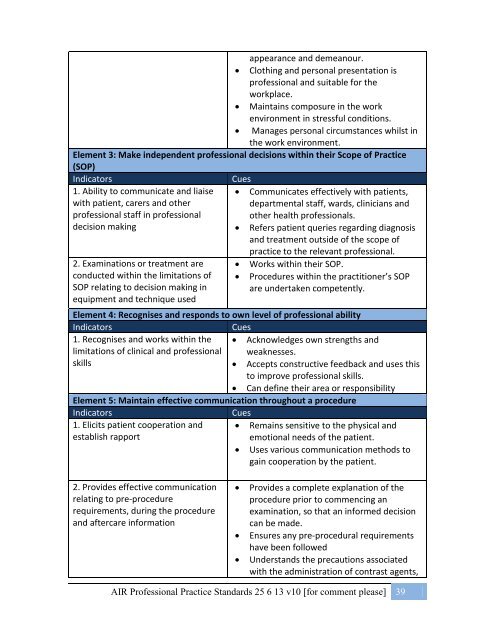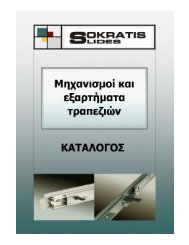Australian-Professional-Standards-Practices
You also want an ePaper? Increase the reach of your titles
YUMPU automatically turns print PDFs into web optimized ePapers that Google loves.
appearance and demeanour.<br />
• Clothing and personal presentation is<br />
professional and suitable for the<br />
workplace.<br />
• Maintains composure in the work<br />
environment in stressful conditions.<br />
• Manages personal circumstances whilst in<br />
the work environment.<br />
Element 3: Make independent professional decisions within their Scope of Practice<br />
(SOP)<br />
Indicators<br />
1. Ability to communicate and liaise<br />
with patient, carers and other<br />
professional staff in professional<br />
decision making<br />
2. Examinations or treatment are<br />
conducted within the limitations of<br />
SOP relating to decision making in<br />
equipment and technique used<br />
Cues<br />
• Communicates effectively with patients,<br />
departmental staff, wards, clinicians and<br />
other health professionals.<br />
• Refers patient queries regarding diagnosis<br />
and treatment outside of the scope of<br />
practice to the relevant professional.<br />
• Works within their SOP.<br />
• Procedures within the practitioner’s SOP<br />
are undertaken competently.<br />
Element 4: Recognises and responds to own level of professional ability<br />
Indicators<br />
Cues<br />
1. Recognises and works within the<br />
limitations of clinical and professional<br />
• Acknowledges own strengths and<br />
weaknesses.<br />
skills<br />
• Accepts constructive feedback and uses this<br />
to improve professional skills.<br />
• Can define their area or responsibility<br />
Element 5: Maintain effective communication throughout a procedure<br />
Indicators<br />
1. Elicits patient cooperation and<br />
establish rapport<br />
Cues<br />
• Remains sensitive to the physical and<br />
emotional needs of the patient.<br />
• Uses various communication methods to<br />
gain cooperation by the patient.<br />
2. Provides effective communication<br />
relating to pre-procedure<br />
requirements, during the procedure<br />
and aftercare information<br />
• Provides a complete explanation of the<br />
procedure prior to commencing an<br />
examination, so that an informed decision<br />
can be made.<br />
• Ensures any pre-procedural requirements<br />
have been followed<br />
• Understands the precautions associated<br />
with the administration of contrast agents,<br />
AIR <strong>Professional</strong> Practice <strong>Standards</strong> 25 6 13 v10 [for comment please] 39

















